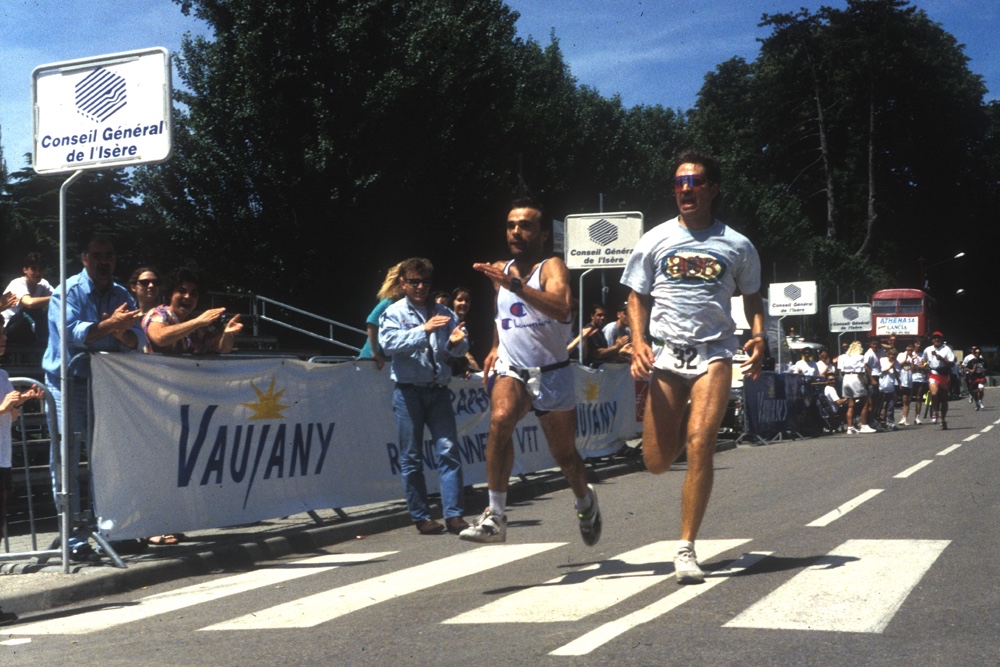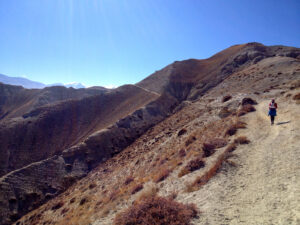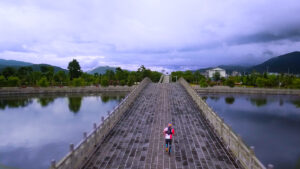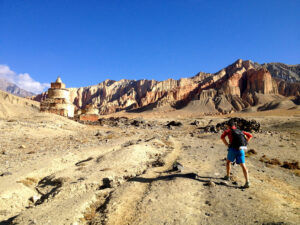RABBIT LAKE, ALASKA, 1993
I awakened at sunrise in a cozy sleeping bag in the Alaskan wilderness. It was -14 degrees out and I was 100 kilometers and 24 hours into a 160 km snowshoe race on Alaska’s Iditarod Trail. It was February, the dead of Winter, and I was hungry.
This was a problem. I only had enough powdered Unipro Endura Optimizer to fill my CamelBak with a 1,200 calorie liquid meal. This is the liquid food that I have used for years as my racing fuel. It provides carbos, protein, and everything else needed to sustain a person without the hassle of chewing. One CamelBak full of this special potion would hopefully be enough to get me 60 km down the trail to the finish line. But after stopping to sleep in a tent at the second of only two checkpoints along the race course, I needed some breakfast, something I could sink my teeth into.
The checkpoint volunteers could not help me; the Iditasport race rules prohibit them from providing any supplies during the race except water.
A lightbulb going on in my head, I headed for the back of the checkpoint tent, where the trash was kept. Surely some of the 50 mountain bikers, skiers, and snowshoers who had gone through this checkpoint during the night had left something to eat.
Breakfast that beautiful, crisp, cold Alaskan morning was my fellow competitors’ throw-aways: three bites of a PB&J sandwich, half a brownie, about a dozen yogurt-covered raisins, and half a StokerBar covered in pocket fuzz.
Renewed by other people’s unwanted calories, I hit the trail and finished the race in good form.
Lesson#1: Scrounge if you have to, but always eat what you need when your life depends on it.
There’s usually something edible to be found, whether in the back row of a 24 hour mini-mart, your friend’s kitchen, or the nearest dumpster.
BERKELEY, CALIFORNIA, 1992
On all fours, I crawled up the half dozen steps from my garage into my house. Vision darkened to a gray-black and with a loud ringing in my head, I groped for the doorknob that would take me into my kitchen. Next, I found myself opening the refrigerator door and grasping the bottle of liquid food I’d left there five hours before. Grabbing a banana and some tortilla chips, I started pounding down the calories.
A flood of sustenance coursing through my veins, my vision returned and the ringing disappeared. I’d gotten into this state of hypoglycemic shock and total glycogen debt for a good reason. I’d put myself there intentionally.
For years, this was a weekly ritual: 125 km on my road bike through the San Francisco East Bay hills on just two bottles of water and a PowerBar. Nothing more allowed. Why? To train my body to live on less, to dig deep and really explore every possible internal fuel source.
It works. In many a race, I’ve been able to compete and cover hundreds of kilometers on foot or bike while only consuming 200 calories an hour or less. Some would say it’s physiologically impossible, but my body knows differently.
Lesson #2: You can learn to live on less in competition if you’ve done it in training.
Internal metabolic efficiency is trainable and attainable. (Just don’t do it all the time or you’ll break yourself down or even hurt yourself.)
DEATH VALLEY, CALIFORNIA, 1990
My support crew pulled up next to me as I climbed out of Death Valley on my road bike and asked if I needed anything. Their jaws dropped as I handed them my empty CamelBak, fully drained of 1,200 calories of liquid food in 75 minutes. “I’ll take another refill,” I said.
We’d started the race just three hours before in Badwater, the lowest point in the Western Hemisphere at 85m below sea level. Our finish line would be 220 km and three mountain passes away on Mt. Whitney, the highest point in the Western Hemisphere. The event was the Mt. Whitney Summit Classic. It was September.
Early in the race, a half dozen racers had broken away and built a five minute gap on the rest of us in the pack. Watching them pull away, I decided to bridge up to them and join in the action. As soon as I got there, though, the breakaway splintered and I was left holding the bag, so to speak. I was off the front alone with a hundred racers chasing me and 160 km to go.
There was only one thing to do. Hammer.
And that had a price: Calories, and lots of them. Without a support crew to refill my CamelBak, not to mention a case of Endura Optimizer in the truck, I couldn’t have done it.
Ten hours after the start, I crossed the finish line in first place. But it wasn’t the course record I’d set that amazed me, it was the 10,000 calories of liquid carbos and protein that I had managed to consume in ten hours.
Lesson #3: High-intensity, high-performance output requires high-caloric intake.
Pound the fuel if you want to pound the pavement. Of course, you can only do this if you have unlimited access to food.
PENTICTON, BRITISH COLUMBIA, CANADA, 1991
Staring at the back of a green plastic door, my bowels let loose in a torrent of what is euphemistically known as Hershey squirts.
As I sat there in a port-a-potty doing my necessary business, fellow racers ran by, enjoying the beautiful views of the Okanagan Valley in Ironman Canada, eight hours into the race.
There were still over 30 km to run and I was having the runs. For the fourth time in 10 km.
And things had been going so well. A good swim, fast transitions, five hours to cover the 180 km bike course, and now the marathon run was all I had left.
Unfortunately, the run part of the race also meant switching from my favorite liquid food in my CamelBak to consuming whatever the race organizers had to offer at the 26 checkpoints along the run course. That meant Gatorade and fruit, both full of fructose and citric acid.
They weren’t going down, or should I say through, too well.
There was only one thing to do: switch to water and chocolate chip cookies, the only other fare they were offering.
So on a well-hydrated cookie diet, my bowels got back to normal and my pace picked up. I shaved 40 minutes off my run split from the year before and broke eleven hours, my goal for my second ever Ironman. And the view was so much better on the race course than inside those green plastic toilets!
Lesson #4: Eat what works.
If you’re getting sick, switch to water and something simple and palatable, while you get your body back under control
BOSTON, MASSACHUSETTS, 1996
Sitting on cardboard in a huge muddy tent filled with a few thousand runners, I was enjoying a sushi breakfast with a half dozen Japanese runners. It was an hour before the start of the 100th Anniversary Boston Marathon.
It was an excellent breakfast in the company of fellow athletes whom I’d just met. And it beat the hell out of the donuts and coffee that everybody else was eating. Caffeine and a sugar bomb do not a breakfast make. But sushi, well, that’s a meal!
This meal was not pre-planned, but it was a welcome godsend. And it helped set the mood, and energy stores, for the day.
Although I hadn’t brought breakfast, I had brought some food for during the race, having learned the hard way not to depend on what race organizers are providing in the way of food.
In the company of 40,000 official runners and probably 20,000 “bandits”, I had a lot of fun that day. It started with the great breakfast and continued with a beautiful, crowd-lined route. I also carried a tiny buttpack with a camera, PowerBar, and two packets of Gu, a quick energy gel. That food, along with the water provided along the way, was all I needed to have a smooth race with no energy problems.
Lesson #5: Be your own chef.
Eat a decent breakfast and bring your own food for the race or workout so that you won’t be at anyone’s mercy.
SOMEWHERE IN MISSOURI, 1987
“We hear you’ve been riding great. Do you want anything special?” my crew asked over a PA speaker mounted on the roof of my support van. “Well, since you asked, I’d like a vanilla shake from McDonald’s!” I replied.
It was day six of the Race Across America and I was rolling through muggy Missouri, expecting to reach the Mississippi River by midnight. My crew was rotating every four to six hours from the motorhome to the spy car to the pace van. I only interacted with those in the pace van behind me, who took care of all my needs.
Not knowing that the previous crew rotation had already given me a milk shake, each new trio was happy to give me “a special treat.” I was taking advantage of them and I knew it, but everything seemed OK.
It wasn’t. Shortly after dark, I started falling asleep and I began experiencing my only hallucinations during the non-stop 5,000 km bicycle race. When you’ve been on a sugar buzz all day, there is only one place to go: DOWN. And down I went, hard. After five great nights that had gone surprisingly well, considering I was only sleeping three hours a night, I fell apart.
I didn’t reach the Mississippi until ten a.m. the next day. I’d lost ten hours to hallucinations, extra sleep breaks, and an eastward pace that could only be called barely rolling. It was all my fault and it would take me the remaining 1,600 km of riding hard, and, most importantly, eating properly, to make up what I had lost.
Lesson #6: Don’t be a self-indulgent idiot.
Eat right. Avoid sugar. Wait until the finish line for the party!
EAGLESONG LODGE, ALASKA, 1995
It was midnight and I’d just limped off the Iditarod Trail into the living room of this remote lodge. It was serving as a special, bonus checkpoint halfway through the 160 km snowshoe race in which I was competing for the second time. What made it special was that it was a building rather than a tent and that it was also a business; you could pay to eat a meal or even sleep indoors for the night. Regular Iditasport checkpoints are just tents in the woods that offer nothing but water and a smile.
I’d been racing for almost 14 hours and I was fried. My tight legs had slowed my pace over the last six hours, making me really feel the -30 degree temperature, and also putting me into caloric debt. I’d taken hours longer than planned between checkpoints, and thus between refueling stops, so I really needed to put something substantial in my stomach.
The trail beckoned, but that warm lodge and its friendly proprietors got the best of me. The next thing I knew, I was slurping down a big bowl of moose chili.
The only problem is, I’m a vegetarian. I hadn’t eaten meat in five years, so while the hot, heavy food really felt good, I was hoping it wouldn’t make me sick.
And as the effects of this wonderful, warm, lovely meal spread throughout my frozen limbs and warmed me to the core, I tried not to think of the big, brave, Alaskan moose that had to die to make it possible.
Rejuvenated and refueled, I finished the race in good form. In fact, that moose stew had such staying power that I only had to regularly sip my Endura Optimizer during the remaining 80 km en route to the finish line in Skwentna.
Lesson #7: Do what you have to do to eat right.
If the fuel’s not in your stomach, it’s not going to your muscles or your brain.
LE FONTANIL, FRANCE, 1993
For 48 hours, I’d eaten nothing but my usual chocolate-flavored racing fuel, Endura Optimizer. And who can call that eating, anyway, when the food is liquid and drunk from a bottle? It was fueling me fine, but I was sick of it.
Behind me was 11.4 km of swimming, 540 km of cycling, and now I was 90 km into the 127 km triple marathon run. They don’t call it the World Challenge of Endurance for nothing.
At this point, my pace was slow. I just wanted to finish in one piece and have a good time. I was running in the company of my support crew and a variety of the locals who had taken me under their wing as I raced around and through their little village over and over again. I was the only American racer who spoke French, as well as the only racer with fingernails painted five different colors. I think they found me entertaining.
At one point, one of my French crew members, Damien, rode up next to me on a mountain bike with a brie-covered baguette in his hand. He intended it as his snack.
I ate it.
And from that point on, I had not one more sip of my high octane racing brew; I was a brie and baguette man through and through. And it didn’t hurt a thing. So close to the finish, with my casual pace producing a low heartrate, and especially with no prize money on the line, I could afford to indulge. And I loved it.
I finished the race in a sprint for 17th place with German triathlete Gunther Teichmann in the middle of a human funnel with a few thousand spectators going wild. Gunther and I tied, despite our best efforts, but it wasn’t that climactic ending that I remember best about that race.
It was Damien’s brie and baguette, surely one of the tastiest race meals I’ve ever had.
Lesson #8: Have fun. Live a little!
The heart of the multisport athlete is in the stomach, after all.
- By Chris Kostman. Originally published in Swedish in MultiSPORT Magazine, Sweden, premier issue, April 1999. Later published in Marathon & Beyond, July 2007.




